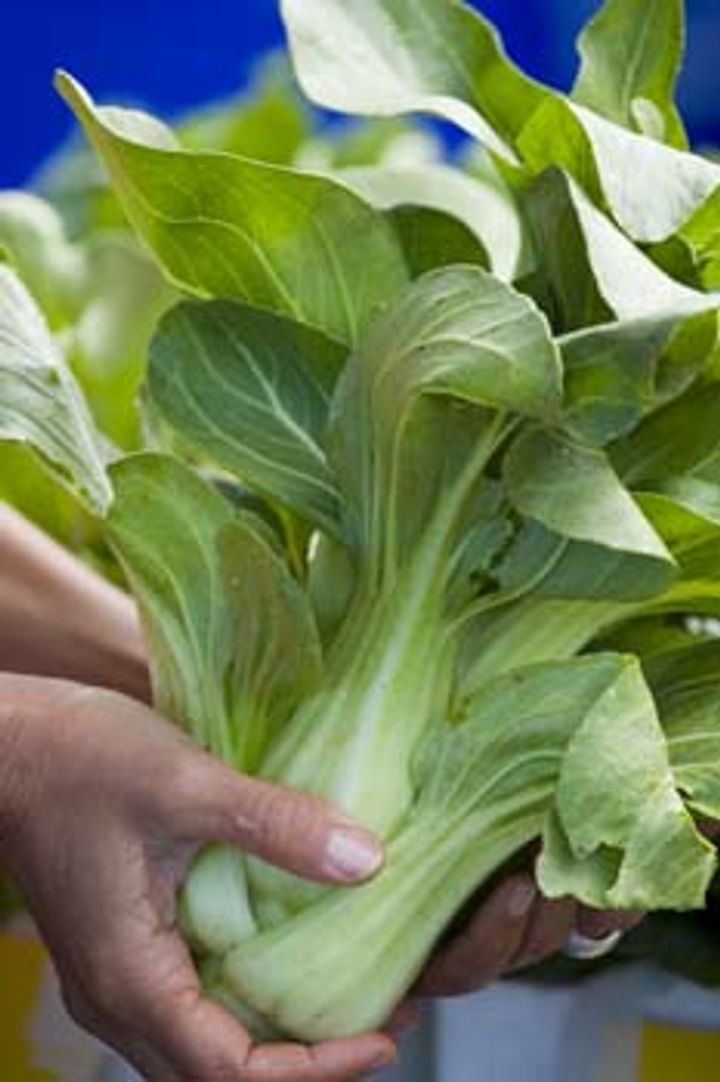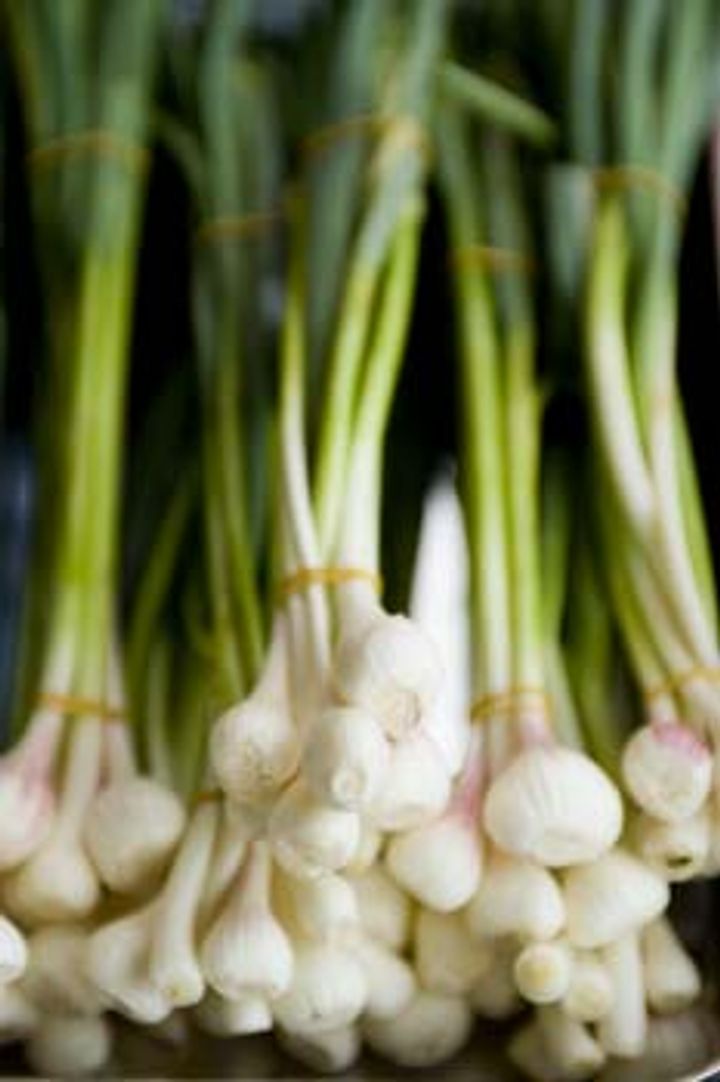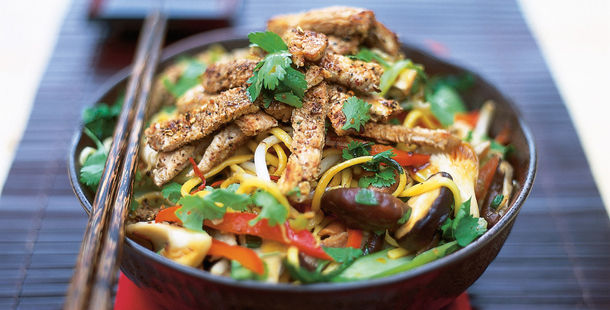There’s a lot to love about a simple stir fry. Firstly the veggies make it out alive or close to it (or they are meant to anyway). They are a quick, colourful, highly nutritious, no-fuss meal. Stir fries are suited to pretty much to any meat or vegetable (although starchy vegetables are the exception here).
One of my favourite things about stir fries is that once you have cut up your meat, chicken fish or veg protein, sliced your vegetables into even sized pieces and whipped up a simple sauce your work is pretty much done. You may need to boil a jug to soak some noodles or turn on a rice cooker, but cooking your stir fry is over in the blink of an eye. There is only one rule when it comes to stir fries: ensure you have all your preparation done before you turn on the heat.
Think of stir fries as warm salads; make sure you add lots of different-coloured vegetables, leafy Asian greens, a small amount of marinated meat and finish it off with your favourite dressing. Stir fries can be served on top of rice or noodles but if you want to mix it up try serving them in lettuce cups or folded inside a thin omelette. The best thing about stir fries is they are pretty impossible to mess up and they are a great way of getting your kids to eat lots of vegetables in one sitting.

I love mixing it up when it comes to the noodles I add to my stir fry. More often than not I will opt for a gluten free option such as fresh or dried rice noodles or bean thread vermicelli. When I am feeling like a more Japanese-style stir fry I might splash out and spoil myself with a pure buckwheat soba noodle. More recently I found a delicious black bean spaghetti, which is absolutely amazing with stir fried beef and mushrooms. I must confess on those rare occasions I do weaken and reach for a wheat based noodle – thick, slippery, white Udon noodles do such a great job of drinking up rich flavoursome sauces.
On days when I don’t fancy noodles I tend to cook up a grain, cool it and add it to my stir fry. Rather than settling for your bog-standard fried rice I’ll use pearl barley, faro or spelt. The beauty of these grains is they are wonderful served piping hot or they make the perfect salad they following day.
The most important ingredient in a great stir fry is a good wok and it need not be expensive If you are lucky enough to have a Chinatown near you whip down there and grab a carbon steel one with a wooden handle (the metal handles are dangerous). Wash the wok well with soapy water to remove the coating the manufacturers put on the surface – this will be the last time your wok sees dishwashing liquid! Your wok needs to be seasoned before you use it. To do this you rub it with a mild flavour oil then heat it until the oil colours – you need to do this about 3-5 times. You must be sure to get it smoking hot, which is much easier to do if you have a gas hob. The seasoned coating will build up over time and create a wonderful non-stick surface.
When your work is ready to go bring your meat or your protein of choice to room temperature so you don’t drop the temperature of wok when you add it. As I mentioned above make sure you have taken the time to cut the meat and vegetables into evenly-sized pieces.
I love to marinate my meat or vegetable protein such as tempeh or tofu before I stir fry. Adding turmeric to any protein not only tenderises it but it makes more digestible, and throw in a bit of ginger to take a big load off your digestive system. Drain off the marinade before you cook your meat and reserve the marinade to use as your stir fry sauce (be sure to boil this as it has had raw meat in it). For those of you who feel as if they have a sluggish metabolism, slice up some long red chilli and add it to your stir fry to give your system a boost, as chilli has been found to increase your metabolism by up to 1/3 and this can be a great thing, particularly in winter when everything feels as if it slows right down.
Salt can sometimes be an issue in stir fries because one the main sauce ingredient is often soy sauce. There a few simple things you can do to keep the salt levels down in your stir fry. Measure your sauces instead of free pouring; I often see my friends stir fry and it looks more like a soup than a stir fry. Your food is only meant to be lightly coated in the sauce, not bathing in it. Use reduced-salt soy sauce and if you need to increase the amount of liquid use a homemade stock rather than more soy, as it will give your stir fry more flavour. Jamie’s Oriental pork with noodles uses low salt dark soy which is richer than your standard soy and the perfect partner for pork. Anytime you add noodles to your stir fry you will probably need to increase the sauce as noodles are thirsty little things and you no sooner add them to your wok than your sauce has vanished. Remember that stir fry sauces don’t need to be elaborate; they can be as simple as a little soy and a squeeze of lime thickened with tiny bit of cornflour. Jamie uses this combo in his Chicken Chow Mein and it works perfectly. A gentle reminder for celiacs or those with gluten intolerance, soy sauce contains gluten so make sure you substitute tamari for it instead. Make sure you check the labels of Asian sauces closely as many are thickened with wheat starch – another reason to buy your own sauces and make your own. Some corn flours also contain wheat, so again, check the ingredients list thoroughly.

So now we have sorted all of the ingredients out, it’s time to get cooking! Get the oil in your wok smoking hot – you will see the oil start to move in the pan – and a haze will appear on top of the oil. Now I want to point out here that you don’t need a lot of oil to cook a stir fry – just enough to fry your onions, garlic and ginger or whatever aromatics you are using. You may want to throw in a few drops of sesame oil for added flavour, and this can be done at the beginning or the end of cooking. Add your meat (or veg protein) to the hot oil in batches, as this will ensure it browns all over, then remove them from the wok so they don’t overcook. Now add your firm longer-to-cook vegetables such as carrots, celery and capsicum. This is where I add a splash or two of water to help the vegetables cook. Don’t be tempted to add any more oil, it simply doesn’t need it. Cook the vegetables for a couple of minutes or until they soften slightly – remember, you want to the vegetables still slightly firm in a stir fry. Finally, add the more delicate quicker-cooking vegetables and greens and your sauce mixture. If you are adding noodles, ensure they are well-drained and cut into manageable lengths and whack them in once the sauce is boiling along with your browned meat. Cook the stir fry until the vegetables are bright green and the meat is warmed through.
Top it off with some toasted nuts or sesame seeds, fresh herbs, fried Asian shallots, crisp sprouts or some thinly sliced chilli. Rinse out your wok but don’t use any soap as it will ruin the season. Simply use a brush to scrape it clean, then dry it completely on top of the hob and rub a little oil over the inside surface once is it cool. This will stop the wok from rusting and preserve the seasoned coating.







![Super breakfast muffins: Jamie Oliver [AD]](https://img.jamieoliver.com/jamieoliver/vi/LMfdYX-krX4/mqdefault.jpg?tr=w-150)















